Shopping Essentials in Meena Bazaar, Dubai
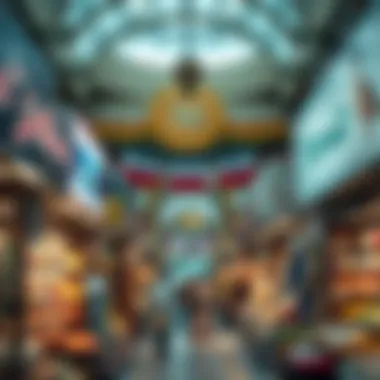
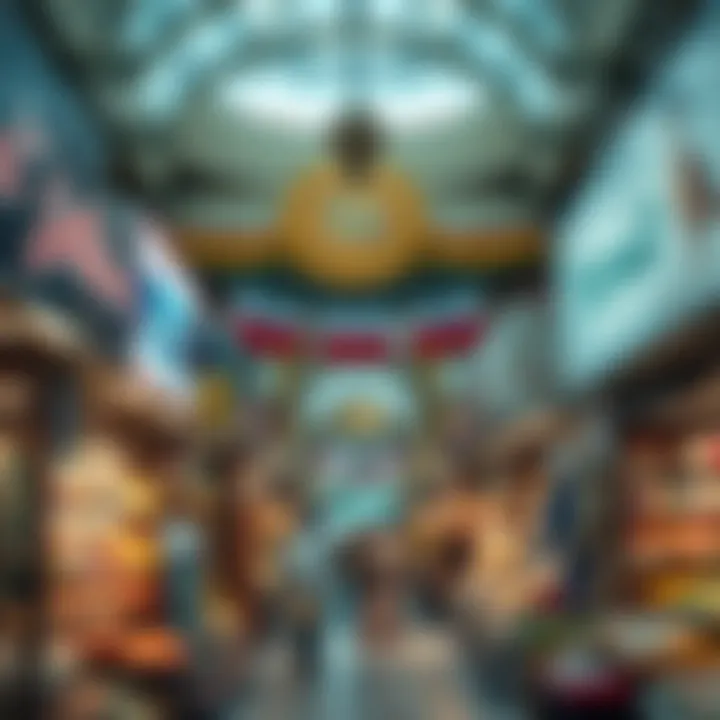
Intro
Meena Bazaar, nestled in the heart of Dubai’s bustling streets, is more than just a shopping destination—it is a vibrant cultural tapestry woven with rich heritage and local charm. For those looking to blend a unique shopping experience with an exploration of Emirati culture, Meena Bazaar serves as a treasure trove. From the moment you step in, the melody of artisans at their work and the scent of spices wafting through the air set the stage for what’s ahead.
Diving into this lively bazaar, you may find the sheer variety of products overwhelming. Think traditional clothing that reflects the region’s history, exquisite jewelry crafted by local hands, aromatic spices that tell a thousand culinary stories, and charming gifts that encapsulate the essence of Dubai. The bazaar not only offers a chance to buy but also provides a window into the customs and everyday life of its residents, making it an unmissable stop for both tourists and locals alike.
In this article, we will navigate through what to buy in Meena Bazaar, highlighting key items, offering practical tips for a smooth shopping experience, and shedding light on the local culture. This guide aims to ensure that your adventure through Meena Bazaar is fun, enriching, and memorable.
Foreword to Meena Bazaar
Meena Bazaar stands as a vibrant hub within Dubai, drawing both locals and visitors alike to its colorful streets and eclectic shops. This marketplace isn't just about shopping; it's about experiencing the mingling of cultures and traditions woven into the fabric of everyday life. The bazaar encapsulates the essence of Dubai's rich heritage, offering a plethora of goods that reflect the diverse backgrounds of the city's residents. This section explores why Meena Bazaar holds a prominent place in the shopping landscape of Dubai.
Historical Background
The roots of Meena Bazaar date back to the days when Dubai was emerging as a trade hub. Originally serving as a trading post for merchants hailing from various parts of the world, Meena Bazaar evolved over time into a commercial heart for the South Asian community in Dubai.
In its early years, this bazaar was frequented by those seeking spices, textiles, and precious jewelry. Today, the market still preserves that charm, albeit modernized to meet today’s consumer needs. Buildings adorned with traditional Arabic architecture snugly house stalls bursting with vibrant garments and intricate jewelry designs. This rich history adds layers of meaning to every inch of the bazaar, making it much more than a place to shop; it's a glimpse into Dubai's past.
Significance in Dubai's Culture
Meena Bazaar serves as a cultural melting pot, showcasing the lifestyle and traditions of the South Asian expatriate community in Dubai. Its significance stretches beyond mere economics; it is a place where cultural exchanges take shape. You’ll find aromas wafting through the air from spice shops alongside sound of raucous laughter from families. In fact, business here is often a communal activity—vendors know their regulars, and deals are exchanged not just for goods, but for stories.
Additionally, the bazaar plays a role in community celebrations, especially during festivities such as Eid. It transforms into a lively space filled with decorations, special merchandise, and a sense of togetherness. Here, people come not only to purchase items but also to connect, celebrate and share moments, reinforcing the integral role Meena Bazaar plays in the social fabric of Dubai.
"In Meena Bazaar, the essence of the Dubai experience can truly be felt; it's where commerce meets culture, creating a unique mosaic of sights, sounds, and flavors."
For anyone looking to truly understand and appreciate what Dubai has to offer, a visit to Meena Bazaar is a must. It brings to life the everyday experiences of countless individuals, blending the traditional with the modern in a way that only a bustling market can.
Traditional Clothing
Traditional clothing in Meena Bazaar holds immense cultural significance. It's not just about fabric and design; it embodies the heritage and lifestyle of the Emirati people. This segment of the market shines a spotlight on unique garments like abayas and kandoras, which are not only stylish but also steeped in tradition. Wearing traditional attire during cultural events or family gatherings signals respect and pride in one’s roots. For anyone visiting the bazaar, these clothing pieces serve as a connection between the past and the present, shaping a vivid portrait of Emirati life.
Abayas and Kandoras
Choosing the Right Fit
Choosing the right fit is essential when selecting abayas and kandoras. An ill-fitted garment could diminish the elegance of these traditional wear. The right fit not only complements one’s body shape but also offers comfort when wearing them for extended periods. Proper sizing accommodates fluid movement, an aspect especially vital during hot days in Dubai. Often, the cut reflects personal styles while maintaining cultural relevance. A snug fit may work for some, while others may prefer a looser style for breathing room, so it's about finding that sweet spot that looks good and feels right.
Fabric Options
The fabric options available in Meena Bazaar are a treat for the senses. From sleek silks that billow beautifully to breathable cottons ideal for warmer climates, the choices vary widely. Each fabric has its own personality; while silk denotes elegance and luxury, cotton offers practicality and ease of maintenance. It’s crucial to consider the texture and weight of the fabric for suitability—heavy fabrics might not be ideal in the scorching heat, whereas lightweight options can enhance comfort. As you browse, paying attention to the fabric can greatly affect durability and overall satisfaction with your purchase.
Price Range
When it comes to price range, abayas and kandoras can fit most budgets. You can find elegant designs at very accessible prices, while exclusive pieces embellished with intricate work come at a premium. Prices can range from affordable, mass-produced items to high-end, designer garments. Being aware of this can guide shoppers effectively; knowing what you’re willing to spend can help you narrow down your options quickly. Additionally, many vendors are open to negotiations, giving you room to articulate your budget, and possibly snag a good deal.
Color and Design Variations
Popular Patterns
Popular patterns in Meena Bazaar reflect a rich tapestry of culture and creativity. Floral designs, geometric shapes, and bold colors often dominate the landscape of traditional attire. Certain motifs hold symbolic meanings, which can be quite fascinating. Integrating popular patterns into your wardrobe lets you be part of the local narrative. A garment that features traditional patterns signifies respect for local craft and an appreciation for artistry. However, the risk lies in picking a pattern that may not transition well into various occasions; hence, selecting versatile designs is advisable.
Seasonal Trends
Seasonal trends play a significant role in shaping what’s available at Meena Bazaar. For instance, during major holidays like Eid, vibrant colors and exquisite designs more commonly appear. Shoppers notice a shift in fabrics as well, with lighter materials being favored in the summer and richer textiles being preferred as the temperatures cool. Keeping an eye on seasonal collections can be advantageous, as traditional styles may embody the spirit of the time, making your purchase not just a piece of clothing, but a reflection of festive cheer. This also means that being attentive to these trends could allow for excellent opportunities to snag unique items before they become widely popular.
Jewelry and Accessories
When one strolls through the bustling aisles of Meena Bazaar, jewelry and accessories shine with a certain allure that is hard to resist. These products are not merely ornamental; they often carry cultural significance and represent the craftsmanship of local artisans. The jewelry found here is a testament to Dubai's rich blend of traditions and modernity. Whether you’re treating yourself or picking up a prized gift, understanding the variety and quality of jewelry and accessories can enhance your shopping experience greatly.
Gold and Silver Jewelry
Quality Standards
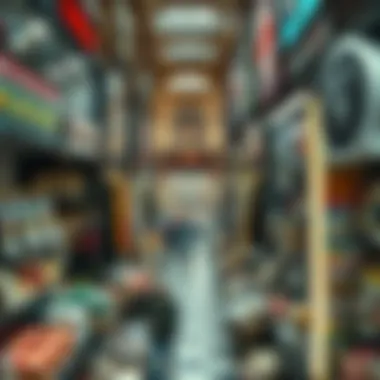
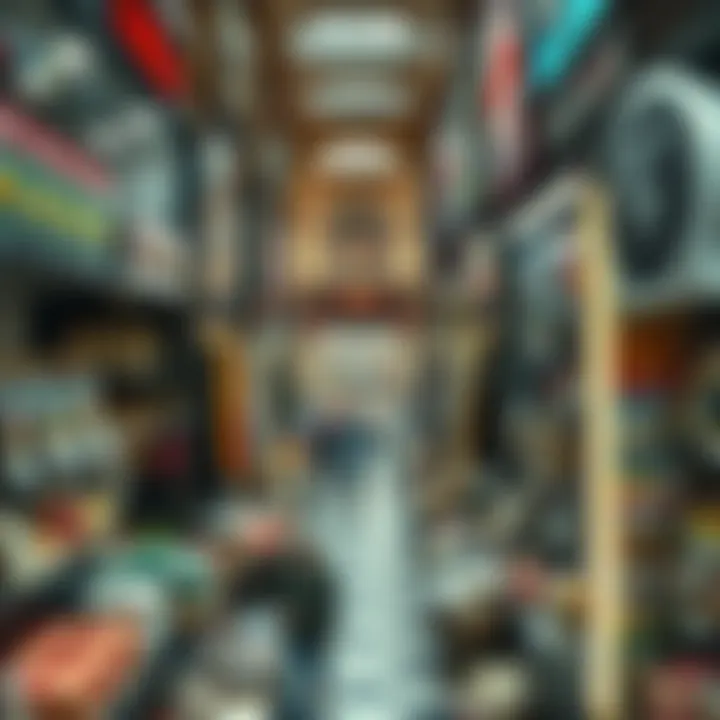
Quality standards of gold and silver jewelry are paramount and can vary significantly across different vendors. In Dubai, for example, gold is typically sold based on the carat system; 24K denotes pure gold, while 18K and 22K are mixed with other metals to provide strength and durability.
It is beneficial to look for the hallmark—this indicates the authenticity and purity of the metal. In Meena Bazaar, one can often spot vendors advertising their gold jewelry with attractive prices, but be cautious, as lower prices might mean lower quality. Vendors should have proper documentation or certification to back their claims, which is a wise practice.
"When buying gold, check for the hallmark and consider weight and carat to ensure you’re making a sound investment."
The unique feature of gold jewelry’s quality standards in Dubai is that they are strictly regulated by the authorities; thus, you can walk away feeling secure about your purchase.
Common Styles
In the realm of jewelry, common styles in Meena Bazaar reflect the region’s aesthetic sensibilities. Traditional designs, often intricate and embellished with gemstones, provide a rich visual tapestry. For example, the Khaleeji style features bold designs that embody a local heritage, while more contemporary styles cater to modern tastes, striking a fine balance between tradition and innovation.
The key characteristic of these common styles is their versatility, making them suitable for various occasions. Whether it’s a casual outing or a lavish wedding, there’s likely an accessory to enhance any ensemble. Considering that these pieces often come with elaborate craftsmanship, they become conversation starters as well. One might find that some modern pieces can be a bit pricey due to the artistry involved, but they are indeed worth the investment.
Precious Gemstones
Types of Gemstones
The market's variety of precious gemstones adds depth and character to the shopping experience at Meena Bazaar. Here, you can encounter a dazzling array of stones, including diamonds, sapphires, rubies, and emeralds, each with its own backstory and significance.
The characteristics of these gemstones are vital; for instance, color, clarity, and cut play essential roles in determining their value. Choosing gemstones can be overwhelmingly diverse, yet it’s beneficial because it opens up numerous options for personal or gift purchases. Some vendors may provide certificates of authenticity, which can reassure buyers of their investment.
A unique feature of buying gemstones in Meena Bazaar is the opportunity for custom designs. Many shops offer services to create bespoke jewelry, allowing you to choose the type of gemstone and setting that suits your taste and budget, making it a personalized experience.
Buying Tips
When hunting for gemstones, having a strategy can serve you well. It is crucial to arm yourself with knowledge about the types of stones and their quality before making decisions. Researching online about pricing trends can provide insight and help distinguish fair deals from rip-offs.
A helpful tip is to always request a certificate of authenticity, which certifies the quality of the gemstones you are considering. Moreover, know the return policy of the shop; this adds a layer of security to your purchase. Many vendors in Meena Bazaar are open to negotiation, so don’t shy away from bargaining to get the best price.
These buying tips enhance the overall value of your visit to the Bazaar, empowering you to make informed decisions.
In summary, jewelry and accessories found in Meena Bazaar embody both cultural significance and modern appeal, making them an integral part of Dubai's shopping experience. As you navigate through the glimmering stalls, keep the quality standards, styles, types of gemstones, and savvy buying tips in mind to ensure a successful and satisfying shopping adventure.
Spices and Local Cuisine
When wandering through Meena Bazaar, the aroma of spices fills the air, inviting you to explore a critical aspect of the region's culinary heritage. Middle Eastern spices are not just for flavoring food; they represent centuries of tradition and cultural significance. Delving into the world of spices and local delicacies is essential for understanding the heart of Dubai's gastronomy.
Types of Spices Available
Popular Middle Eastern Spices
Among the spices that define Middle Eastern cuisine, saffron holds a special throne. Known for its vibrant color and distinct flavor, this spice is often seen as a mark of luxury. Cumin, with its warm, earthy flavor, and coriander, which adds freshness, are fundamental in various dishes from stews to salads. The use of these spices not only enhances taste but also promotes health benefits, like digestion support.
What makes these spices both beneficial and popular lies in their versatility. They can be used in numerous dishes, from masalas to grilled meats, imbuing them with unique characteristics that guests and locals alike have come to love. The intriguing feature of these spices is their ability to tell a story of the culture and history, making them more than mere ingredients.
"The spices from the Middle East are not just flavor enhancers; they are a testament to centuries of dialogue between trade routes and cultures."
Usage in Cooking
Understanding the usage in cooking is crucial for anyone looking to enhance their culinary skills. Spices are foundation stones in traditional dishes. For example, without the correct blend of spices, a dish like biryani would lose its soul. Learning to manage the balance of flavors can dramatically improve a meal. That said, incorporating spices into everyday cooking isn’t without its challenges—overuse can lead to overpowering flavors resulting in a dish that's hard to enjoy.
Cooking with spices also encourages creativity in the kitchen, allowing one to experiment with flavors and spice blends. This jewel of culinary art shows how a sprinkling of a specific spice can make or break your cooking experience.
Local Delicacies
Must-Try Foods
Moving beyond spices, local delicacies are at the forefront of Meena Bazaar's culinary offerings. When in Dubai, it would be foolish to miss out on shawarma, a rolled-up delight often filled with perfectly spiced meat and crisp veggies that almost everyone in the desert would recommend. Another must-try is hummus, a smooth chickpea dip that serves as a staple. The combination of these dishes showcases the incredible harmonies possible within Middle Eastern cooking.
Furthermore, these foods are not just delicious; they’re also affordable and widely available, making them accessible to both locals and travelers alike. These delicacies each carry a narrative of their own, giving anyone tasting them a glimpse into life around here.
Where to Buy
For those keen on purchasing these local delicacies, Meena Bazaar serves as the perfect hub. Vendors often sell fresh falafel, baklava, and even kebabs, boiled bright fresh ingredients that tempt shoppers. Small eateries line the paths of the bazaar, where you can experience these foods firsthand in an authentic atmosphere.
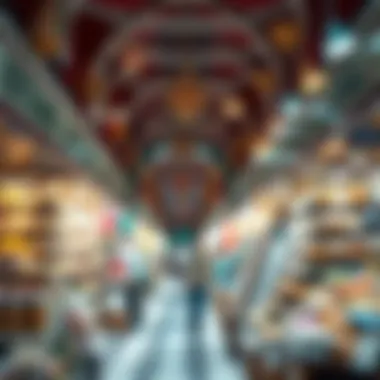
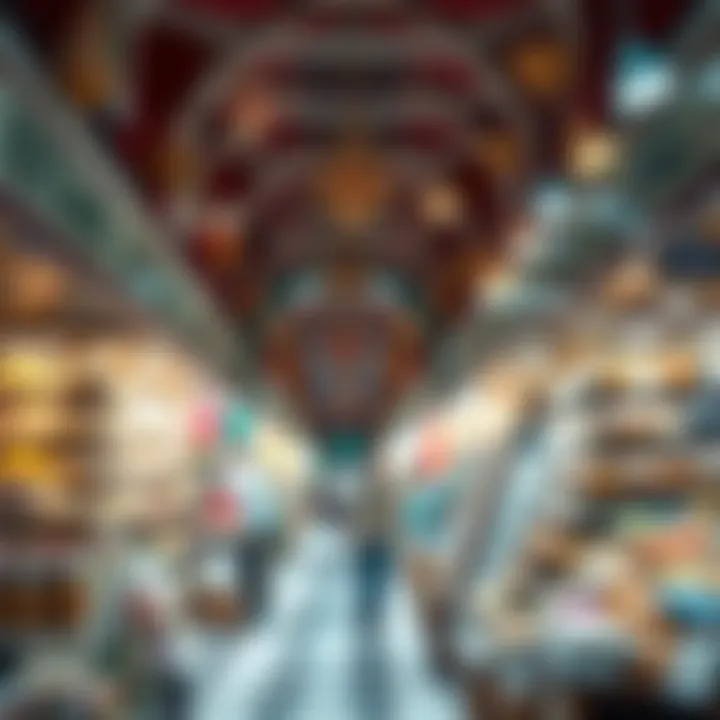
While chain restaurants provide consistency, the real joy lies in the traditional eateries tucked within the bazaar’s nooks, presenting a more genuine experience. Be mindful, however, as peak hours can lead to crowds. Thus, visiting these local spots during quieter times can allow for a better experience, ensuring you savor the exquisite tastes without the need to rush.
Unique Gifts and Souvenirs
When wandering through the bustling lanes of Meena Bazaar, one will quickly grasp the significance of unique gifts and souvenirs in capturing the spirit of Dubai’s vibrant culture. These items often prove to be not just merchandise, but also heartfelt tokens of memory, providing a tangible connection to the experience of this iconic market. Visitors and residents alike find themselves enamored with items that tell a story, reflecting the artistry and traditions of the region.
Artisan Crafts
Handmade Pottery
Handmade pottery is a standout aspect of Meena Bazaar’s artisan crafts. The beauty of these pieces lies in their individuality; no two items are exactly alike. Artisans carefully mold and paint each piece, often using traditional methods passed down through generations. This means that choosing a ceramic vase or a decorative dish doesn’t just mean picking a pretty item for your shelf—it embodies a history and a craft that is unique to the region.
One particular characteristic that delights buyers is the use of natural glazes that result in vibrant yet earthy tones, often reflecting local colors and styles. These pieces add warmth to any home and serve as great conversation starters. However, one should be mindful of the fragility of handmade pottery, as it can be susceptible to chipping or breaking if not handled with care.
Textile Products
Textile products in Meena Bazaar are a joyful explosion of color and texture. The offerings often include intricate scarves, elegant table runners, and richly embroidered cushions. What makes these textile products special is the craftsmanship behind them. Each stitch tells a story of the artisans who poured their heart into creating them. Not only do they serve to beautify one’s space, but they also become cherished keepsakes that echo the local culture.
A key feature of these textiles is their versatility; they can be worn, displayed, or even gifted. Be it a lightweight pashmina for those cool Dubai evenings or an ornate tablecloth for entertaining guests, there is always something to fit the occasion. On a downside, care must be taken with washing and maintenance, as some materials might require dry cleaning to preserve their quality.
Traditional Home Decor
Lanterns and Ornaments
Lanterns and ornaments provide a glimpse into the rich design heritage of the Middle East. These pieces often combine intricate metalwork with vibrant glass, creating stunning visual displays. They are not simply decorative; they serve as a nod to tradition, making them a worthy addition to any home. Many are designed to be functional as well, casting a warm glow that enhances the ambiance of a room at night.
The craftsmanship of these lanterns is indicative of the local culture, showcasing designs that draw upon Islamic art. Opting for these as gifts can also serve as a reminder of the vibrancy of Dubai’s marketplace. However, it is essential to be cautious when placing these decorative items, as they can be delicate and prone to damage.
Wall Hangings
Wall hangings are an exciting way to bring a piece of Dubai’s cultural aesthetics into one’s home. These artistic creations can range from fabric tapestries to decorative plates, each carrying its own unique design inspirations. Often handcrafted, they showcase motifs and colors specific to the region, making them a symbol of local pride.
A notable characteristic of wall hangings is their ability to transform a space without the need for extensive renovation. One or two can instantly elevate the character of a room. However, depending on the material, they might require specific types of mounting or care, which is worth considering when making a purchase.
Navigating the Bazaar
Navigating Meena Bazaar can be quite the adventure. This bustling market is not just a place to shop; it’s a window into the heart of Dubai’s vibrant culture. Knowing how to maneuver through the myriad shops and stalls can significantly enhance your experience. A few essential elements to consider will make all the difference, whether you're a local or a visitor.
Understanding Local Etiquette
Appropriate Behavior
When stepping into the lively surroundings of Meena Bazaar, understanding appropriate behavior is crucial. First and foremost, showing respect for local customs will go a long way. The market is often filled with families and groups enjoying their time, so maintaining a polite demeanor can create a more pleasant atmosphere.
One key characteristic of appropriate behavior is quietness. While it’s easy to get carried away with excitement, loud conversations or public displays can draw unwanted attention. Instead, a gentle tone of voice is more appreciated and ends up being a beneficial choice for everyone. Furthermore, dressing modestly is another aspect. While tourists may be tempted to wear casual summer gear, opting for more conservative clothing shows respect for local traditions. The unique feature of behaving appropriately is that it fosters a bond with local vendors and shoppers alike, making interaction more effortless and positive.
Interacting with Vendors
Interacting with vendors in Meena Bazaar can be an art form in itself. The vendors are not just shopkeepers but often storytellers, eager to share details about their products. Building rapport enriches the shopping experience and can lead to better deals. It’s important to approach them with a smile and openness.
A key aspect of interacting with vendors is using simple, clear English or even a few Arabic phrases if you can. This not only shows effort but also makes the vendor more inclined to answer your questions and engage in conversation. The distinctive feature here is mutual respect—vendors appreciate when shoppers are knowledgeable about their goods. However, the downside can be that without understanding local nuances, communication may occasionally falter. Aim for patience and understanding, as it pays off in the long run.
Best Times to Visit
Peak Hours
Understanding peak hours is paramount when planning your visit. Generally, Meena Bazaar is most crowded during weekends and evenings, especially from Thursday to Saturday. This buzz can create a vibrant atmosphere but could also lead to longer wait times at stalls and difficulty in navigating through the crowd. Knowing when the busy hours are can allow for strategically timed visits.
Visiting during peak hours does have its perks, such as experiencing the liveliness of market life. However, finding a moment to engage deeply with vendors can be a challenge due to the high foot traffic. Instead, consider visiting during quieter hours earlier in the day for a more relaxed exploration.
Seasonal Considerations
In addition to time of day, seasonal considerations play a role during your visit to Meena Bazaar. The cooler months from October to March are more conducive for shopping, as temperatures drop, allowing visitors to roam comfortably. Knowing the seasons helps you plan not just your attire but also your shopping itinerary.
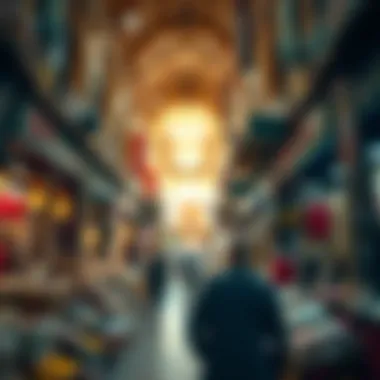
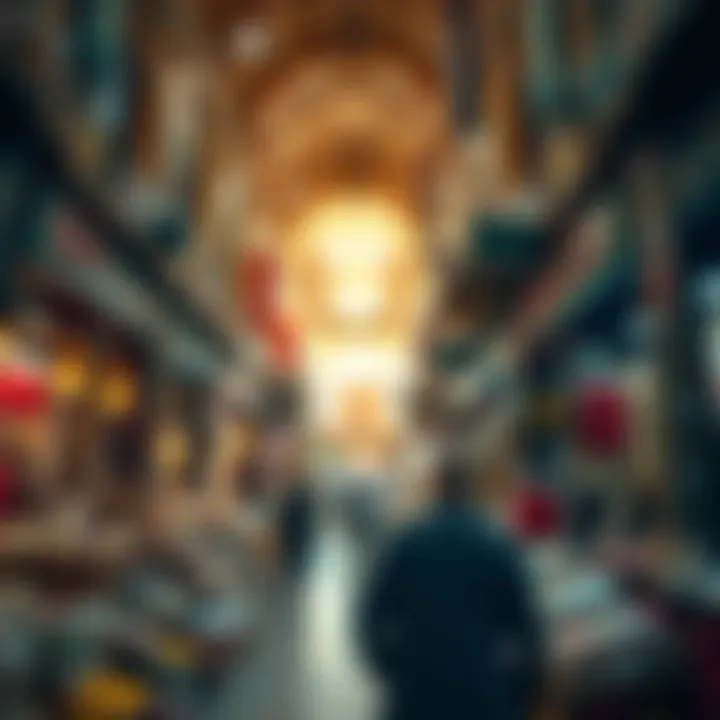
Additionally, festivals such as Eid can bring specialized stalls and unique items for sale. The benefit of visiting during these times is the availability of exclusive goods that aren't always present. However, be prepared for the hustle and bustle that comes with festive shopping, as the crowds can swell.
The essence of shopping in Meena Bazaar lies not only in the items purchased but in the experiences gained by navigating its vibrant space with cultural understanding and respect.
Navigating Meena Bazaar effectively prepares visitors for a uniquely enriching experience, boiling down to understanding local etiquette, the best times to visit, and the art of interacting with vendors. This knowledge allows for a well-rounded exploration that is as immersive as it is engaging.
Payment Methods
Understanding the various payment methods available at Meena Bazaar can greatly enhance your shopping experience. In an environment as dynamic as this bustling market, knowing how to transact smoothly can save both time and frustration. Whether you prefer to pay in cash or by card, being informed about these options is key to maximizing your purchases.
Acceptable Payment Options
Cash vs. Card
When it comes to payment options at Meena Bazaar, cash tends to be the favored choice among both vendors and shoppers. This preference springs from a few notable characteristics. For one, cash transactions can often lead to faster exchanges, avoiding the delays associated with processing cards. Plus, some vendors might not have card facilities, particularly in smaller shops, making cash the more practical option.
However, there are benefits to using cards too. Using a debit or credit card gives you the advantage of added security, especially if you are carrying large amounts of cash. There’s also a chance to earn rewards or cashback with a credit card. That said, it’s advisable to check if your card is accepted in the specific shops you plan to visit, particularly in smaller establishments that may have limited infrastructure.
- Pros of Cash:
- Pros of Card:
- Instant transactions
- More widely accepted in small shops
- No bank fees associated
- Enhanced security
- Potential for rewards
- Easier for tracking expenses
Exchanging Currency
If you're visiting from abroad, understanding how to exchange your currency can greatly affect your spending power while shopping. Currency exchange services are readily available in Dubai, and you can often find them located near Meena Bazaar. One major advantage of exchanging currency in the market area is the competitive rates often offered by local traders, which can sometimes rival those of banks.
One aspect to keep in mind is the fees associated with currency exchange. Some places may charge a service fee which can eat into your savings. On the other hand, exchanging cash at designated kiosks is usually a straightforward process that can yield better rates than withdrawing cash from ATMs.
- Pros of Currency Exchange Kiosks:
- Considerations:
- Competitive local rates
- Convenience of location
- Watch out for hidden fees
- Exchange rates may fluctuate
Bargaining Practices
To truly experience the essence of shopping in Meena Bazaar, you need to embrace the art of negotiation. Bargaining is not just permissible; it's expected. This aspect adds a layer of cultural engagement that can transform your shopping experience into something memorable.
Negotiation Tips
Having some negotiation strategies up your sleeve can greatly influence the final price of your purchases. A key aspect of bargaining is to approach it with a friendly demeanor. Vendors appreciate buyers who engage in light banter, making the back-and-forth exchange something more than just transactional.
Start by showing interest in an item but express a willingness to walk away if the price doesn’t suit your budget. Always begin negotiations lower than your true buying limit; this provides room for both you and the vendor to arrive at a mutually satisfactory price. It might feel a little strange at first, but it will become second nature once you get into the swing of things.
Common Price Markups
It’s critical to be aware that prices in markets like Meena Bazaar may be marked up to accommodate room for negotiation. Vendors often set prices higher than what they are willing to accept, so understanding this common practice is important. By knowing that markups exist, you can negotiate more effectively, ensuring you aren't paying more than necessary.
These price fluctuations are largely influenced by factors such as demand, seasonality, and even the vendor's own supply needs. Being savvy about these elements can help you gauge a fair price and position yourself better during your negotiation.
- Things to Keep in Mind:
- Understand that both you and the vendor are aiming for a fair deal
- Be ready to walk away if the price feels off
- Stay aware of peak tourist seasons that might inflate prices
Being equipped with knowledge about payment methods and negotiation can change your overall experience in Meena Bazaar from merely shopping to truly exploring a cultural gem. Treat each transaction as an opportunity to engage and learn, ensuring that your time spent in the market is both enjoyable and educational.
Ending
Visiting Meena Bazaar is more than just a shopping trip; it's an immersive experience that captures the very spirit of Dubai's multicultural charm. This conclusion serves to underline the key elements that make the bazaar a quintessential part of any visit to the city.
Summary of Key Takeaways
- Diverse Offerings: Meena Bazaar is a treasure trove of traditional clothing, jewelry, spices, and unique gifts. Each item holds a story of its own, reflecting the rich cultural tapestry that is Dubai.
- Cultural Insight: Beyond the products, the bazaar provides insight into local customs and traditions—valuable for both expatriates and tourists aiming to engage more deeply with the culture.
- Practical Information: Understanding payment methods, bargaining practices, and the best times to visit can make your shopping experience much more enjoyable. Adapting to local etiquette ensures smoother interactions with vendors and fellow buyers.
- Exploration Opportunity: Meena Bazaar also offers a glimpse into Dubai's historical and social fabric, helping shoppers appreciate not just what they buy but the context of their purchases.
Encouragement to Explore
Don’t just aim to tick items off a checklist; instead, embrace the journey through Meena Bazaar. Each corner holds surprises and unique finds. Whether it's an intricate piece of gold jewelry or aromatic spices to elevate your cooking, the bazaar beckons you to discover its myriad offerings.
Wander through the vibrant lanes, engage with local artisans, and let your senses guide you. You may stumble upon something unexpected that piques your interest—perhaps a handmade textile that captures a moment, or a rare spice that brings the flavors of the Middle East into your kitchen.



